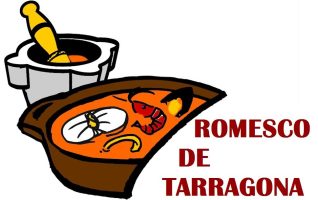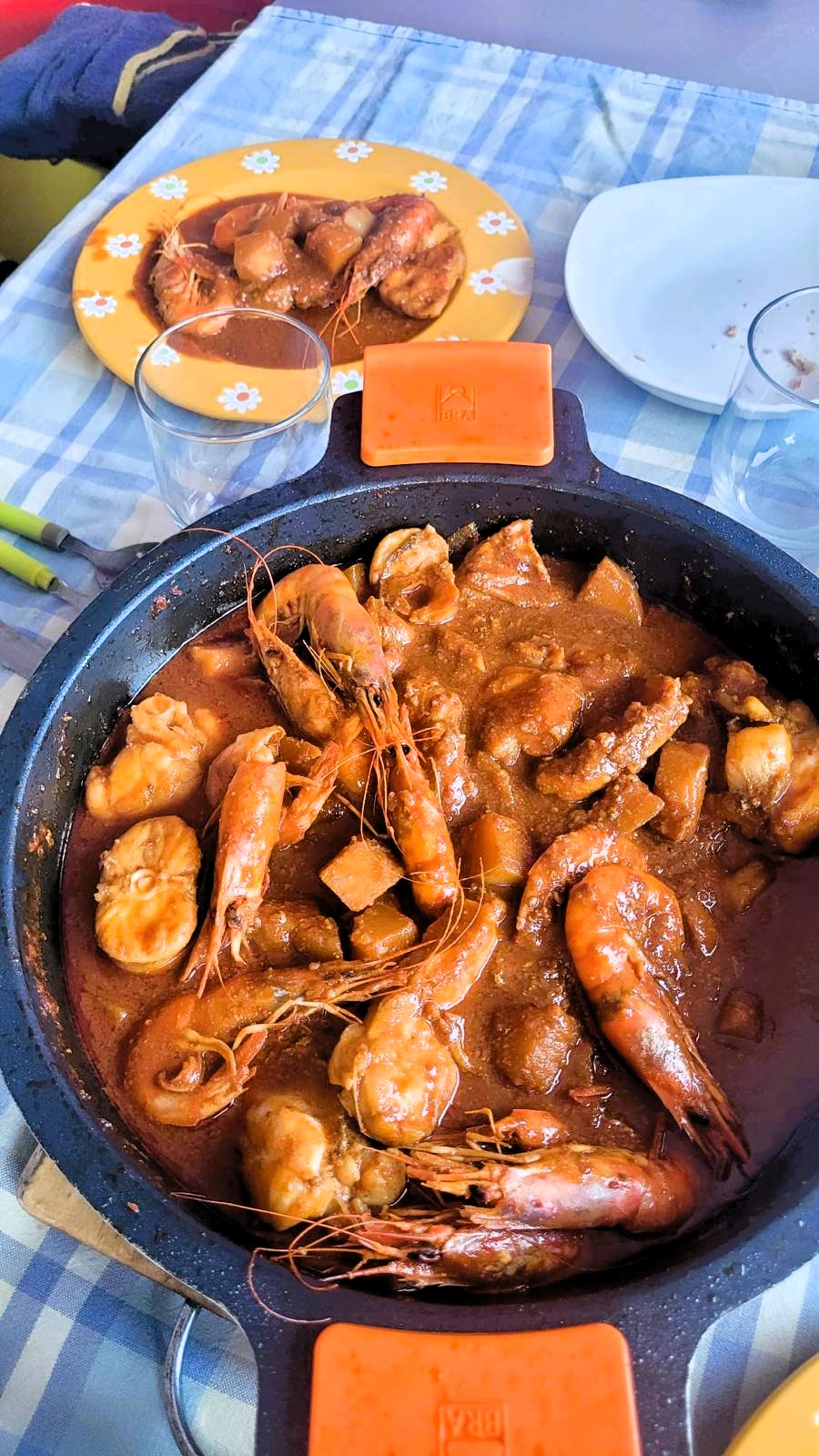This Romesco could be considered a classic recipe and can be made with many types of ocean fish. Originally it would only carry fish, although in this case it has been enriched with potatoes, beans, cuttlefish and some seafood, with the idea of offering a more complete and festive dish.
Ingredients for 6 people:
• 2 fried dried ancho peppers (see the section How to fry the dried ancho peppers for the Romesco recipes).
• 6 garlic cloves, peeled.
• 1 sprig parsley, finely chopped (if you have it).
• 1 small peri-peri chilli (expendable).
• 10 almonds and 10 hazelnuts. Better if they are roasted, not raw, fried or salty. They must be peeled one by one from the fine dark skin that covers them (blanched).
• 1 glass of white wine.
• 100 g of fresh striped tomato.
• 200 g of cooked beans (from a glass jar, well washed).
• 350 g of cuttlefish.
• 1.1 kg. of clean and chopped fish (see chapter Bases and ingredients of Romesco).
• 900 g of potatoes.
• 500 g. of Japanese clam.
• 6 norway lobster.
• 850 ml of soft fish stock.
• 90 ml of extra virgin olive oil.
• 2 thin slices fried bread from a 250 g loaf.
Preparation.
Preparation of the Romesco base mix:
• We start by frying the slices of bread on both sides until golden brown, taking care not to burn them and letting them cool on absorbent kitchen paper.
• We prepare the peri-peri chilli by cutting its upper part and emptying it of seeds.
• Add the tomato, the nuts, the garlic cloves, the parsley, the chilli, the fried slices of bread, the wine and mix well. The wine serves mainly to dilute the mince so that the mixer can work, so the right amount of wine will be added to achieve it. Since this recipe uses striped tomatoes, it could be that the necessary amount of wine to add is minimal.
• Now add the fried dried ancho peppers and reduce everything to a fine paste with the mixer.
Preparation of the dish:
• We peel the potatoes and cut them into pieces about the size of a walnut, trying not to cut the whole piece of potato each time, but breaking the last cut with a slight lever with the knife.
• In this recipe we are going to use a low non-stick casserole with a diameter of 32 cm, although others can be used. First, add the cuttlefish and a glass of water to the casserole and cook over medium heat until the cuttlefish is completely dry. Now we should not add salt or pepper.
• We pour the 90 ml. of extra virgin olive oil and mix well with the cuttlefish pieces.
• Now add the Romesco base mix, mix and fry it for about two minutes over medium heat and stirring constantly with a wooden spoon, in order to prevent it from sticking (we enjoy this fantastic aroma).
• Add the potatoes and broth to just cover the potatoes. We mix everything well.
• Bring it to a boil and count for approximately 15 minutes over medium heat, stirring from time to time. We taste the salt and add a little pepper. Almost at the end of the 15 minutes, we add the beans and distribute.
• We now put the pieces of fish (previously seasoned), arranging them one by one in the stew. In the case of the video on this website, it is turbot. If necessary we can add a little more broth, but always hot and in moderation.
• We put the clams and the norway lobsters on top, cover and cook over medium / low heat for another eight minutes, while the clams are opened and the fish and shellfish are cooked.
• Let it rest for about five minutes.
• We place with care and patience, trying to have everything in each dish and adding a sufficient amount of sauce to each one.
Variations.
• You can opt for a basic version of this dish, which would bring it closer to the historical and traditional recipes of fish Romescos. For this, you can do without clams, cuttlefish, crayfish, potatoes, beans and tomato, leaving the fish as the full protagonist, along with the more traditional minced Romesco base. In this case, the quantity of fish can be increased to approximately 2 kg, so that each diner has a sufficient quantity of food.
• As mentioned in the chapter see chapter bases and ingredients of Romesco, different fish can be used. If you want to use monkfish, it is recommended to scald it beforehand. To do this, we immerse the slices once clean in a small saucepan with boiling water and a little salt for about 30 seconds, so that the fish curdles slightly and loses part of the water. We use the scalded slices in the recipe and discard the hot water.
• There are those who lightly coat and fry each slice of fish, in order to prevent it from falling apart in the stew. This can be tested particularly with fish with less firm meat such as hake.
• You can add onion. For this, it will be necessary to use 250 g finely chopped or even grated onion, which will be candied in a separate pan with a thread of oil and over low heat for a minimum of 15 minutes. The onion thus prepared will be added at the same moment in which the potatoes are added, to continue with the recipe normally. The result will be a Romesco whose flavor will have a softer undertone.
• As mentioned in our tips and tricks section, it may be a good idea to lightly fry slightly the potatoes in the same casserole right at the beginning, after adding the oil, adding the Romesco base mix later.
A wonderful Romesco of monkfish and shrimp made by Joan, a supporter of our portal:

